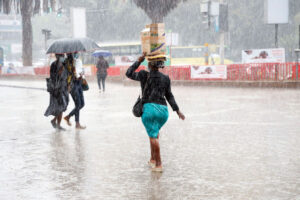Heavy rains are expected to start early next month.
Written by Zenna Issa on February 23, 2024
Most parts of the country will receive above-normal rains in the coming planting season, which will begin early next month.
Weathermen said they are fairly confident of this, adding that chances of heavier rains are above 70 per cent.
The March-May long rains season is the most important in Kenya and forms at least 40 per cent of all the rains the country receives.
The update was given by meteorologists from the Nairobi-based Igad Climate Prediction and Applications Centre, who have been meeting in Kampala to compare models for the March-May season.
“We expect wetter than normal conditions over most parts of the region. Particularly western Kenya and [Kenyan] borders with Uganda, South Sudan and Ethiopia,” said Dr Hussen Endris, a climate modelling impact specialist from Icpac.
The rains are expected to begin in southern Kenyan areas bordering Tanzania, then move to central and spread toward western Kenya.
The scientists noted the rains will be heaviest in April, and end in May in many places.
“In Kenya, the long rain season accounts for more than 50 per cent of its rain so it’s very critical,” Hussein said.
The forecasters noted there’s agreement for early onset of the rains over most parts of Kenya but some parts, especially near Somalia, will suffer delayed onset.
However, they are still unsure of the exact onset dates.
Hussein said most global models give varying on-set dates.
“In parts of Kenya we have seen disagreements with global models, 10-20 days,” he said.
He said this year closely matches 2010 and 2016. “In 2015 we had one of the strongest El Nino and was followed by 2016,” he said.
The climate scientists from Icpac and national modelling teams from the region have been working for the last week in Uganda to develop the forecast.
“We have used nine global prediction forecasts and downscaled for the region,” Hussein said. “There’s a more than 70 per cent probability of the rains exceeding the average in the region.”
Kenya Meteorological Department is expected to scale down the forecast and give a localised version by the end of this month.
Met director Dr David Gikungu said there is a lot of speculation if the El Nino, which is waning fast, will be replaced by La Nina, which brings dry weather to Kenya.
“We are in a very unusual situation and even non-climate people have been suggesting we will go to La Nina because that’s what they have seen before,” he said.
Climate scientist Dr Stefan Lines, who spoke at the meeting, said the El Nino conditions and the Indian Ocean Dipole have no impact on the March-May rains.
“It is still too early to predict if the El Nino will be replaced by La Nina,” he said.
Dr Stephan currently leads the International sub-seasonal and seasonal outreach team at the Met Office, UK.
Despite the heavy rains, Kenyans will also see dry spells within the period where rains will stop and sunny conditions will rule for several days, the forecast showed.
The heavy rains are expected to lead to a good harvest for the long rainy season.
Most parts of Kenya experience two rain seasons: March to May-long rains and October to December-short rains.







 NRG Radio Uganda
NRG Radio Uganda  NRG JAZZ
NRG JAZZ  NRG MIXOLOGY
NRG MIXOLOGY  NRG RnB
NRG RnB  NRG AFROBEATS
NRG AFROBEATS  NRG GOSPEL
NRG GOSPEL  NRG DANCEHALL
NRG DANCEHALL  CHOICE.RADIO
CHOICE.RADIO  NRG HIPHOP
NRG HIPHOP